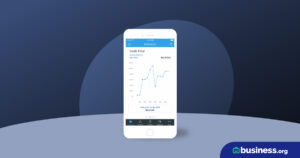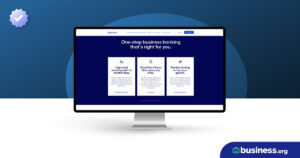💸 See if your business qualifies for a tax credit worth up to $26k per employee. 📞 Call Now: 855-979-9597
What Is a Business Line of Credit & How Does it Work?
We are committed to sharing unbiased reviews. Some of the links on our site are from our partners who compensate us. Read our editorial guidelines and advertising disclosure.
Even if you carefully balance your books, cash flow problems happen. Clients drag their feet on paying invoices, but you still need to pay your employees. Your office fridge breaks and makes a melted mess of the leftover ice cream from last week’s employee birthday party, but you haven’t budgeted for fridge repairs. Your supplier has a huge sale, but you won’t have the working capital to take advantage of it until next month.
Business owners often experience these kinds of cash flow issues. If you’re not prepared, they can pose a significant problem.
Fortunately, a business line of credit (LOC) can alleviate cash flow difficulties. Keep reading to learn all about how a line of credit can cover your business’s short-term finance needs.
What is a business line of credit?
By signing up I agree to the Terms of Use.
How a business line of credit works
A business line of credit provides business owners with a flexible form of financing. It functions as revolving credit—that is, you have a credit limit and can use and pay back funds on an as-needed basis. Unlike a loan, your line of credit will only be charged interest on the money you actually use.
For example, let’s say you open a LOC with a credit limit of, say, $50,000. You’ll draw money as needed—maybe $1,000 to purchase some deeply discounted inventory and maybe $30,000 so you can make payroll on payday. You’ll pay interest on that $31,000, and you’ll have $19,000 left to use. But if you pay back $10,000, you’ll have $29,000 to use.
Business line of credit vs business credit card
You might also think a business credit line sounds pretty similar to your credit card―and you’re not wrong. They’re both types of revolving credit.
The big differences? Well, a business credit card usually has a much lower credit limit than a business line of credit. Likewise, business credit cards generally have higher interest rates than credit lines do.
That means that business credit cards work better for small day-to-day expenses, like team lunches, office supply runs, and so on. Business credit lines work better for larger cash flow needs, like bigger purchases, hiring, and business improvements.
(For more details, we’ve got a breakdown of lines of credit vs. credit cards.)
Unlike a business credit card or term loan, a business LOC works best for taking care of large(ish) short-term credit needs, like making payroll or taking care of surprise expenses—more on those and other uses in a minute. But first, let’s talk about why you’d want a business line of credit instead of a term loan.
The difference between a term loan and an LOC
Both a loan and a line of credit provide funds for your business needs, but the two work pretty differently.
With business loans, you get an up-front lump sum when you take out the loan. You repay that loan in its entirety, plus interest, over a set period of time. If you need more money, you’ll have to apply for and take out another loan.
With a line of credit, you get a credit limit and then draw money against that limit on an as-needed basis. You make payments only on the money you’ve drawn (plus interest). As a form of revolving credit, you’ll have continual access to more funds as you make payments. You spend, you pay back. Spend, pay back. Rinse, repeat.
A line of credit generally has a lower APR than a business loan of the same amount, and the maximum credit limit on an LOC tends to be lower than the maximum term loan amount. That’s because terms loans and lines of credit have very different uses.
How to use a business line of credit
While you can use an LOC for just about anything, you probably shouldn’t. Business owners should primarily use their line of credit for short-term expenses as a way to help with cash flow.
For example, if you’ve recently completed several big jobs for several clients, you might be expecting a big payday. Your bills, however, don’t wait for accounts receivable. In cases of cash flow issues like these, you can use your line of credit to get the funds to pay your bills. Then, when you get that accounts receivable windfall, you can use it to pay back your LOC.
But that’s just one of the many ways you can use an LOC to supplement your cash flow. You can also use it for purposes like these:
- Make payroll
- Handle surprise repairs and replacements
- Purchase inventory or supplies
- Ride out seasonal revenue shifts
- Take advantage of limited-time opportunities
Just remember, reserve your line of credit for your short-term credit needs to cover gaps in cash flow.
For small, day-to-day expenses (think staplers, break room snacks, and team swag), you’re better off using a business credit card. For big, long-term expenses (like real estate or fleet expansion), you’ll want a term loan.
Keep in mind that the kind of short-term expenses you’ll want a line of credit for often come up unexpectedly. Nobody plans for their cappuccino machine to explode or for their competitor to have a jaw-dropping going-out-of-business sale.
That’s why you shouldn’t wait until you already have cash flow needs to start looking at lenders. Get a line of credit before you need it. That way, you won’t find yourself up a creek without a cash advance.
Aside from use as a short-term credit solution, a business line of credit helps build your business credit. Simply use your line of credit, then promptly pay it off. You’ll build a solid credit history, which will help you avoid future difficulties getting a loan with bad credit.
Rates, terms, and fees you should know
There are two primary categories of lenders for business lines of credit: traditional banks and online lenders. Traditional banks often offer more appealing conditions—lower APRs, longer terms, and higher limits—but young businesses may struggle to meet their more stringent application criteria.
Regardless of who you use as a lender, don’t sign up for a line of credit without knowing all the important details. You’ll want to pay particular attention to credit limits, interest rates, term length, and additional fees. These will vary from lender to lender, but we provide some rough estimates below.
Credit limits
Popular online lenders offer lines of credit that range from $2,000 to $250,000. Banks offer significantly larger lines of credit, but again, those will be harder to qualify for.
APR
You can think of APR (annual percentage rate) as your interest rate plus everything else—transaction fees, loan origination fees, late penalties, and pretty much any other costs. While an interest rate only reflects, well, interest, an APR should better reflect your actual yearly cost by factoring in your interest rate and those other fees.
Online lenders offer an APR from as low as 9% to as high as 99%, though typical rates range from 20% to 40%. You’ll generally find lower APRs at a traditional bank—often between 5% and 13%.
Terms
Terms for a line of credit from an online lender can be as short as 12 weeks or as long as 36 months. Terms between 6 and 12 months are most common. Traditional banks offer longer terms ranging from one to five years.
Other fees
Depending on your lender, your draws may also come with individual origination fees (because again, you’re basically taking out individual term loans). You may also face prepayment penalties for repaying your draws before schedule.
Your lender may also charge an annual fee for your small-business line of credit. Unlike the other fees we mentioned, this fee will apply whether or not you actually use your credit line. So if you plan to get a business credit line just in case, make sure you know what kind of annual fee you’ll have.
How to get a business line of credit
As you’d expect from any form of business financing, you’ll need plenty of documentation to get an LOC. Expect to produce your personal tax returns, business tax returns, financial statements, bank statements, and your personal credit history.
Once you have all that together, you can start talking with lenders.
Qualifying for an LOC
The precise qualifications for a line of credit will vary from lender to lender. As a rule, online lenders are more lenient. However, that leniency often comes with lower credit limits and higher interest rates.
Typically, you’ll need to have been in business for at least six months and have an annual revenue of at least $25,000. Most lenders expect a credit score of at least 600. Of course, having the bare minimum in each category isn’t likely to get great results. Revenue of $50,000 and a credit score of 700 will get you a lot further.
You can compare line of credit offers from many different lenders on the Lendio business loan marketplace.
Keep in mind that some lenders discriminate based on business size. They might not lend to home-based businesses or businesses with fewer than three employees. If that’s your business, you might have to look a little harder for a lender.
If you don’t qualify for a business line of credit, consider microloans. While they don’t have identical uses, there is some overlap, and microloans tend to have less-strict lending qualifications.
Collateral and personal guarantees
To get a large line of credit (over $100,000), you’ll likely need to produce some form of collateral, such as equipment, assets, or real estate. Smaller lines generally don’t require collateral, but they may require a personal guarantee.
A personal guarantee obviously poses a risk to you as the borrower. To reduce that risk, negotiate specific terms for the personal guarantee—specify a time limit, for example, or specify assets.
Better yet, shop around for a lender who won’t require a personal guarantee. Many lenders will forego a personal guarantee if you have solid business credit already. Likewise, some lenders won’t ask for a personal guarantee if you seek a low credit limit.
Credit reductions and call ins
As with all credit, borrow wisely. If you fail to make payments, your line of credit could be called in, meaning your lender closes the lines and requires full payment within a short period of time.
Even if you pay promptly, a drastic reduction in business revenue could lead to a lowering of your credit limit. According to the National Small Business Association, around 10% of small-business owners have an LOC called in, and 29% experience credit limit reductions.3
The XXX factor
While lenders mostly care about things like your revenue and credit score, some lenders won’t extend lines of credit to certain industries. If your business falls in the gambling, adult entertainment, or marijuana industries (among others), you’ll have a harder time finding lenders.
Even outside those categories, certain industries pose more risk to lenders, making it harder for you to get financing. Seasonal businesses, for example, may struggle to find funding—so don’t expect to easily get a line of credit for your Christmas tree lot or Halloween costume store.
Pros and cons of business lines of credit
So now that you understand how business lines of credit work, should you get one? Maybe―but let’s make sure you understand the pros and cons of this type of business financing first.
Pros
As we’ve told you, credit lines can work for many kinds of working capital needs. They’re very versatile compared to other financing options. That makes them a great fit for all kinds of businesses, from online stores to B2B businesses to medical offices.
And of course, your business will be able to draw from your credit line over and over again. That makes small-business lines of credit way more convenient than applying for a term loan (or other types of business financing) over and over again whenever you need more money.
Since you don’t have to re-apply, business lines of credit often offer faster funding than other types of business loans. You can often get cash the same day you make a draw (or the next day at the latest). In fact, some lenders even give you a card that works just like a debit card, so you can make instant draws in stores. In comparison, many term loans take several days to appear in your bank account.
Cons
But lines of credit aren’t all gravy.
First of all, depending on your lender, business lines of credit can get expensive. Online lenders often offer accessible credit lines, for example, but they come with higher interest rates than lines from traditional lenders (that is, banks or credit unions). Likewise, if your credit line has an annual fee or origination fees, you may end up paying way more than you’d like in fees alone.
(Still, lines of credit tend to be cheaper than things like merchant cash advances, invoice factoring, and even many short-term loans.)
And then there’s the difficulty of getting a line of credit in the first place. Online lenders have made them more accessible, yes, but lines of credit aren’t always the easiest to qualify for. So if you have a low credit score or a very young business, for example, you may have trouble getting approved.
On the whole, though, we think the pros of business credit lines outweigh the cons.
The takeaway
A business line of credit can provide a useful way to handle short-term expenses and to compensate for cash flow interruptions. Just make sure you understand terms and conditions before you sign on the dotted line.
Interested in getting a line of credit for your business? Check out our reviews of the best business lines of credit.
You can also check out some related topics like American Express Business Loans Review, Currency Capital Equipment Financing, Payability Review, Loanbuilder Paypal App, Best Unsecured Line of Credit, What is an EIDL Loan, Minority Small Business Grants, How to Find Private Lenders, Kabbage vs Fundera, or Credit Sesame Review.
Related reading
Business line of credit FAQ
No, a business line of credit is not the same as a loan. Although they both provide funds for your business, they operate differently. A loan is a lump sum you borrow and then pay back with interest. A business line of credit gives you an amount of money that you can borrow from but you are only charged interest on and required to pay back the portion of that initial amount you borrowed.
In order to qualify for a business line of credit, you usually need a credit score of 600, $100,000 in annual revenue and one year in business. Of course, requirements differ between lenders but in most cases these are the minimum requirements necessary.
Yes, borrowers taking out business lines of credit are required to pay interest but generally these APRs are lower than on business credit cards.
You can have anywhere between 12 weeks to 36 months to pay off a business line of credit. As explained higher in the article, traditional banks do offer longer terms often ranging from one to five years.
Disclaimer
At Business.org, our research is meant to offer general product and service recommendations. We don't guarantee that our suggestions will work best for each individual or business, so consider your unique needs when choosing products and services.
- Rasmussen Reports, “Most Small Business Owners Still Looking for Recovery Signs”
- U.S. Small Business Administration, “The Importance of Building Business Credit”
- U.S. Small Business Administration, “Which Unsecured Lines of Business Credit Are Best for Your Business?”





